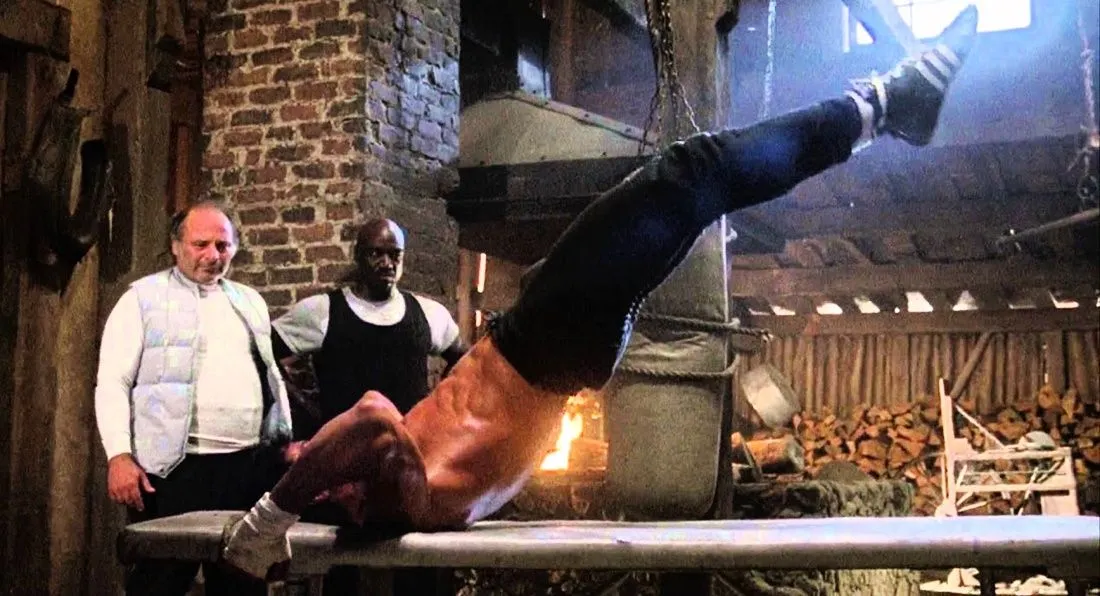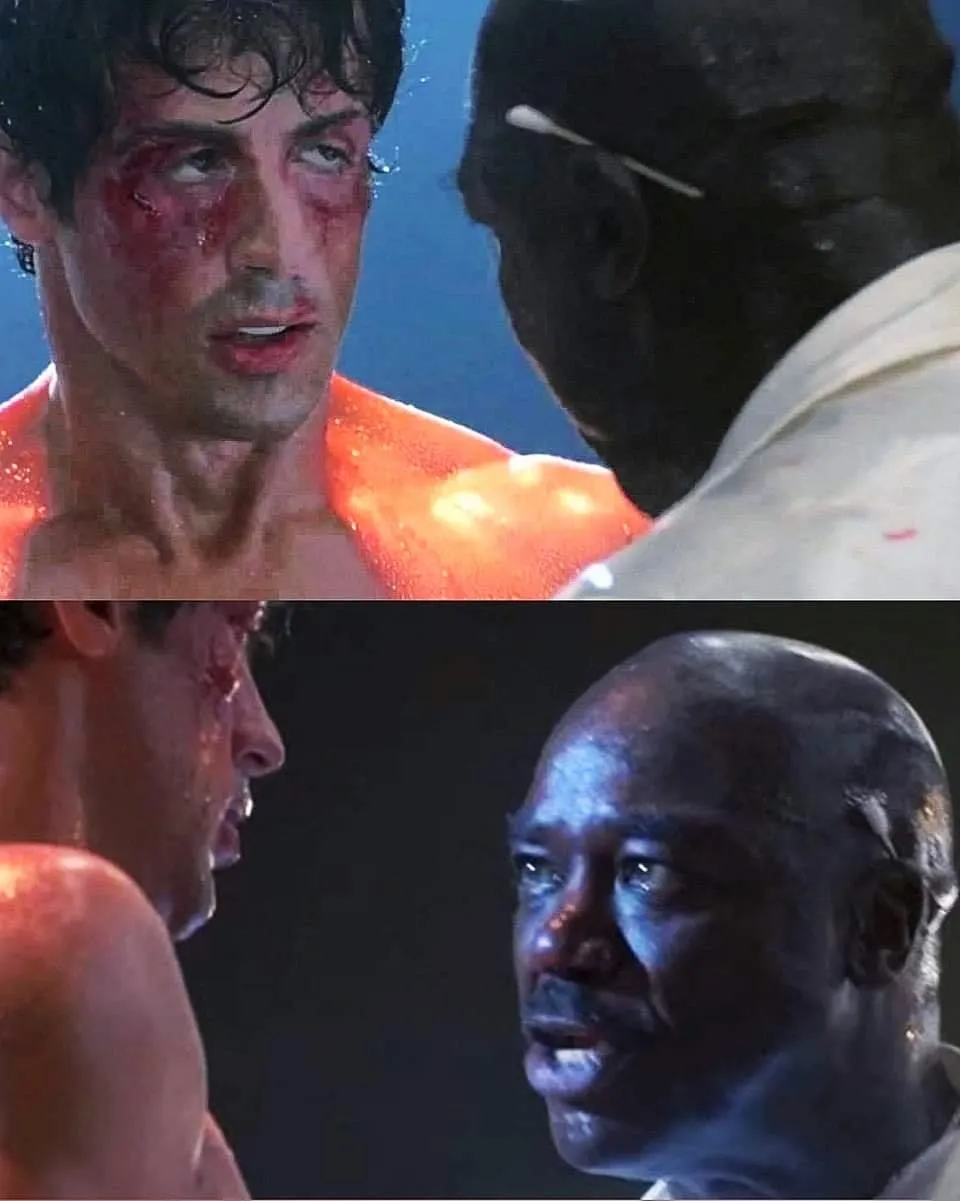Se me dificulta no asociar la banda sonora y algunas imágenes allí proyectadas con ejercicios de alto impacto. Menos mal que cuando me inicié en la actividad física, al cumplir los 20 años de edad, tenía cierta noción de lo que era la realidad y la ficción, por tal razón aplicaba mi propio criterio sobre las posibilidades de que lo planteado en este tipo de películas pueda suceder, sobre todo en lo que respecta a un gran cambio físico en muy poco tiempo y al recurrir a una motivación destructiva para alcanzarlo.

Fuente
Es evidente que Rocky IV es un panfleto ideológico, pero también representa la cima de esta saga que desde su primera entrega presenta básicamente una misma historia, el protagonista es un boxeador que acepta un difícil desafío, se somete a un riguroso entrenamiento y logra evolucionar en lo físico y en lo mental. Por supuesto que en cada filme la argumentación se va acentuando hasta alcanzar niveles absurdos, pero al ser una película, la lógica indica que los productores intentarán persuadir al público para que considere creíble aquello que no es real.
Entre todas las escenas hay una que llegó a marcar a varias generaciones, lo sé porque cuando comencé a practicar deportes y a entrenarme con frecuencia en los parques y plazas donde habían barras fijas y paralelas, los allí reunidos solían hacer referencia al “No duele, no duele” cuando alguien ya estaba al límite de sus fuerzas y amenazaba con abandonar la repetición.
Tal frase, inmortalizada por el actor Tony Burton, en su personaje de Tony “Duke” Evers, pasó a la posteridad cuando intentaba sugestionar a Rocky Balboa para que siguiera adelante con su enérgico entrenamiento ignorando el dolor y también en la pelea final al pronunciarla para que Rocky se olvidara de los golpes que había recibido.

Así que aquel “No duele” pasó a ser una referencia en gimnasios y sitios de entrenamiento sobre todo por la creencia popular de que el dolor trae ganancia muscular y mientras más se tolere mejores serán los resultados. Durante doce años consecutivos llegué a realizar ejercicios físicos y aprendí a identificar y soportar el dolor hasta completar las rutinas que cada semana eran más exigentes, en aquel entonces la juventud y la imprudencia pudieron más que el sentido común.
Hasta que el cuerpo dijo basta y aparecieron las lesiones, primero una tendinitis en el hombro derecho, luego se presentó en ambos codos, posteriormente una bursitis en el manguito rotador derecho y aunado a ello la formación de una especie de tumoración a nivel de la escápula derecha, que luego de varios años se descubrió que era un músculo roto en los deltoides cuyas fibras se calcificaron sobre un nervio cercano al cuello.
Tras unos diez años de descanso forzado y diversos tratamientos, incluyendo una operación, he vuelto al entrenamiento, pero esta vez desde una perspectiva más saludable, por supuesto consciente de que estoy muy lejos de ser aquel joven que inició el camino.
Ahora, con tal experiencia acumulada, no puedo evitar sonreírme recordando aquel “No duele, no duele” de la película mientras Rocky jalaba un saco repleto de pesadas piedras, realizaba un press militar con una carreta, derribaba un árbol en segundos o hacía abdominales al estilo bandera del dragón, escenas aderezadas con los temas musicales Heart’s on Fire y Burning Heart. Sin duda, el poder de la ficción puede derrotar a una lesión de espalda, a una hernia o a un desgarre de tendones.


I was around ten years old when I first watched the movie Rocky IV on television, and I remember the next day everyone at school was talking about it, especially the training sequences and the music, leaving the story and final fight in the background, in those years the Cold War did not worry children. Since then I have watched the film on several occasions and I must admit that its sequences still feel inspiring, although I never tried to imitate the exercises featured in it.
I find it difficult not to associate the soundtrack and some images from the film with high impact exercises. Luckily, when I started exercising, when I turned 20 years old, I had a certain sense of what reality and fiction were, so I applied my own judgment about the possibilities of what is presented in these types of movies actually happening, especially regarding a drastic physical change in a very short time and resorting to destructive motivation to achieve it.

Fuente
Rocky IV is obviously an ideological pamphlet, but it also represents the pinnacle of this saga that has essentially the same story since its first installment. The protagonist is a boxer who accepts a difficult challenge, undergoes rigorous training, and evolves physically and mentally. Of course, in each film, the storyline becomes more exaggerated, but being a movie, logic suggests that the producers will try to persuade the audience to believe what is not real.
Among all the scenes, there is one that has marked several generations, I know this because when I started practicing sports and training frequently in parks and squares where there were horizontal and parallel bars, the people gathered there used to reference the "No pain, no pain" phrase when someone was already at the limit of their strength and threatened to stop the workout.
That phrase, immortalized by actor Tony Burton, in his character Tony "Duke" Evers, became famous in a scene where he tried to motivate Rocky Balboa to keep going with his intense training, ignoring the pain, and also in the final fight when he said it to make Rocky forget the blows he had received.

So that "No pain" became a reference in gyms and training sites, especially because of the popular belief that pain brings muscle gains and the more pain tolerated, the greater the results. For twelve consecutive years, I did physical exercises and learned to identify and endure the pain to complete routines that became more demanding each week, youth and recklessness prevailed over common sense.
Until my body said enough and injuries appeared, first tendinitis in my right shoulder, then in both elbows, then bursitis in the right rotator cuff, and in addition the formation of a kind of tumor at the level of the right scapula, which after several years was discovered to be a torn muscle in the deltoids whose fibers calcified over a nerve near the neck.
After about ten years of forced rest and various treatments, including surgery, I have returned to training, but this time from a healthier perspective, of course, aware that I am far from being that young man who started the journey.
Now, with such accumulated experience, I cannot help but smile recalling that "No pain, no pain" from the movie while Rocky pulled a sack full of heavy stones, did a military press with a cart, knocked down a tree in seconds, or did flagpole-style sit-ups, scenes accompanied by the musical themes Heart's on Fire and Burning Heart. The power of fiction can undoubtedly overcome a back injury, a hernia, or a tendon rupture.

Traducido y formateado con Hive Translator por @noakmilo.
Translated and formatted with Hive Translator by @noakmilo.